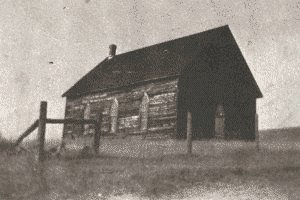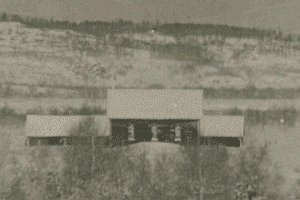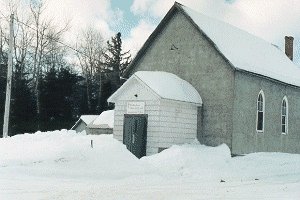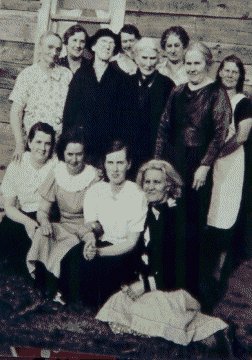|
Back to Settlements Introduction Overview Farming School Hall Transportation Everyday Life |
 The church is perhaps the most enduring monument of the pioneers of Kynoch. The fact that they were able to construct it with no outside help is evidence of the spirit of cooperation that was necessary in pioneer times. In the early years, the pioneers attended church services in the home of James and Catherine Reed, in Bellingham. This settlement had been named for Donald Bell. One of its distinctive features was the rapids on the Little White River, which were called Bell's Falls. In time, the Reeds donated two acres of land on which to build a church. This land was on the west bank of Bell's Falls. Bees were held to prepare the land and construct the church. Everyone donated logs for the church. Donald Bell, who had a sawmill, cut the logs into lumber. Women worked in the fields, unusual in those times, so men could work on the church 
The first service in Bellingham Presbyterian Church was held in February 1897. Later a Sunday school was started in the home of William McAulay. Subsequently it was moved to the school and then the church. The church was furnished with benches from an old logging camp until 1901 when chairs were purchased. Also purchased was a pump organ. Membership in the church had increased from 13 in 1897 to 48 in 1905. The Ladies Auxiliary was formed in 1914. They raised money for church expenses through fowl suppers and box socials.
In 1921, the churches of Wharncliffe, Goldenburg, and Bellingham were attached to one charge. Rev. Williamson started the practice of traveling by horseback from one church to another. The Bellingham Young People was a society that was active in the community between 1930 and 1938. A group of about 37 members would meet on a weekly basis to discuss various subjects, sing hymns, and study scripture. Bellingham joined the United Church under the charge of Iron Bridge in 1937. In 1953, the Ladies Group purchased a furnace for the church, which had previously been heated by a box stove. In the 1970s, the future of the church was uncertain. An amalgamation was proposed between Iron Bridge and Blind River charges. This would have resulted in the closure of Bellingham United Church, which at the time had 25 active families. Opposition to the closure was so great that Bellingham was saved. The church remains open and celebrated its centennial in 1997.  |
Home | Natural Environment | History | Industry | Personalities/Stories | Credits/Team
